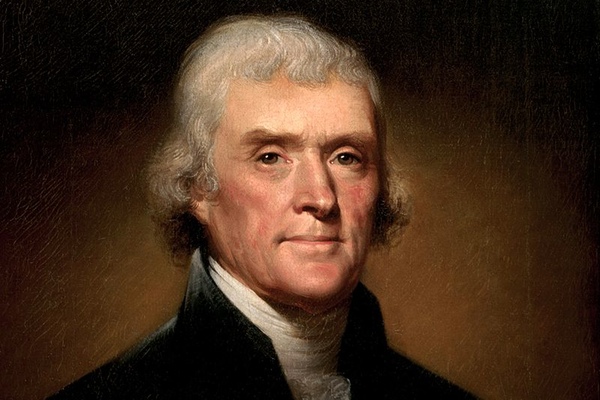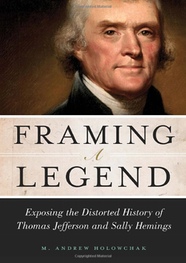Is Jefferson the Fall Guy for the Problems of Our Time?

Finding Jefferson’s Shadow
In his watershed work The Jefferson Image in the American Mind (1961), Merrill D. Peterson argues that our task as Jeffersonian historians is in some sense Sisyphean. Aiming to situate Jefferson—to find the real Jefferson—we merely wind up with an image, a shadow, which is as obfuscatory as it is disconcerting. It is obfuscatory because it is shadowy, and like a shadow whose length is altered with the movement of the sun, Jefferson’s image seems to change with every new investigation of it. It is disconcerting because shadows are epiphenomena whose existence depends on a causal substance, and in investigating Jefferson, we seek the substance and not its aftereffect, but all we seem to find is the aftereffect. What is worse, attempts to disambiguate the image seem to tell us more about ourselves and the problems of our own time than about Jefferson and the problems of his time.
 The problem is ingeminated by Gordon
Wood in Jefferson in His Time (1993). “Where Jefferson …
of the 1920s, ’30s, and ’40s had been the solution [to the
problems of America], Jefferson for his present generation has become
the problem. The Jefferson that emerges out of much recent
scholarship therefore resembles the America that many critics have
visualized in the past three decades—self-righteous, guilt-ridden,
racist, doctrinaire, and filled with liberal pieties that under
stress are easily sacrificed.”i
Wood continues. “No historical figure can bear this kind of
symbolic burden and still remain a real person.”
The problem is ingeminated by Gordon
Wood in Jefferson in His Time (1993). “Where Jefferson …
of the 1920s, ’30s, and ’40s had been the solution [to the
problems of America], Jefferson for his present generation has become
the problem. The Jefferson that emerges out of much recent
scholarship therefore resembles the America that many critics have
visualized in the past three decades—self-righteous, guilt-ridden,
racist, doctrinaire, and filled with liberal pieties that under
stress are easily sacrificed.”i
Wood continues. “No historical figure can bear this kind of
symbolic burden and still remain a real person.”
Years later (2007), Peter Onuf makes the point thus: “Letter writing defined the parameters of Jefferson’s world. He assumed different voices in performing different roles as a correspondent…. Historians who look for disclosures of an authentic self behind these many voices and roles will be frustrated. Jefferson’s self is in his writing, and his fundamental commitments to equality, consent, and civility inform all his varied self-representations.”ii Thus, when we penetrate beyond the different voices of Jefferson and look for an authentic self, there is none. “We are doomed to cluelessness in our own world, like Plato’s cave, a domain of shadows and hand-me-down light.”iii Doomed to cluelessness, “how can we expect historians and biographers to explain to us an intensely private man who has been dead more than a century and a half?” We cannot, he asserts, but the public’s clamoring for the character of Jefferson, who has become a heroic synecdoche for America,iv and for moral assessment of it compels historians to pursue Jeffersonian biographies. In response to public clamor, historians work from Jefferson’s shadow to construct what he calls “possible Jeffersons.”v
Seeking Jefferson’s Substance
Peterson, Wood, and Onuf are representative of the many other historians who believe that the search for the historical Thomas Jefferson is quixotic, not reasonable.
Yet Peterson, whose thesis is responsible for much of the confusion on Jefferson today, never claimed it's impossible to get beyond Jefferson’s shadow. In his “Introduction to the Virginia Edition” of his The Jefferson Image, he writes, “I came to him backwards, substance following shadow.”vi Though the route was backwards, Peterson did come to see, or at least have a glimpse of, the real Jefferson.
Petersonoffers a plausible explanation for the perplexities and inconsistencies among Jeffersonian scholars of his day, and ours. Like many others, he too calls Jefferson—qua philosopher and politician, aristocrat and democrat, and cosmopolitan and American—a “baffling series of contradictions.”vii
The difficulty is that Jefferson—a man of great intellectual breadth and depth, and a man of uncommon ideals—wrote voluminously and appealed to everyone at some cognitive or visceral level:
In his life and in his vision, Jefferson transcended politics. He stood for a cultural heritage Americans could admire, cherish, perhaps be elevated by, but could not hope to possess in its fullness. Its remnants lay everywhere—in what Americans thought, in how they were educated and governed, in the way they worshipped, in the sciences they professed, in the houses they built, the words they used, the foods they ate. Jefferson stood for a life planned and executed in full human scale, for thought down to the last detain, for a mind that related every fact to every other fact in the universe, for a life … given “wholeness and mental order.”viii
Because Jefferson appeals to everyone at some level, scholars give numerous depictions of him. “In his letters, account books, and other memoranda, Jefferson left ample records of his personal tastes and habits; yet, as with his public record, it was possible to draw from these almost any picture the writer wished.”ix Furthermore, Jefferson often dissimulated. “More ardent in his imagination than his affections, he did not always speak exactly as he felt towards either friends or enemies. As a consequence, he has left hanging over a part of his public life a vapor of duplicity, or, to say the least, of indirection, the presence of which is generally felt more than it is seen.”x Moreover, Jefferson was fundamentally a curious immixture of everyday citizen and philosopher. “It was precisely because Jefferson combined, or seemed to combine, the traits of the man-of-the-people and the man-of-vision that he was capable of being mythicized as the Father of Democracy.”xi
Yet Peterson does not believe, as does Onuf, that we write in a domain of shadows and hand-me-down light. We might have to work from shadow to substance, but we are not doomed to cluelessness. The perplexity is in the scholars, not in Jefferson. Peterson writes: “The historians could not fairly plead the lack of information on Jefferson. If still fragmentary, it was constantly on the increase. The difficulty was less one of the scholars’ knowledge than of the uses they made of it. The image of Jefferson shattered when they came through the doors of partisan, and perhaps hereditary, prejudice to the interpretation of the facts.”xii Jefferson was, in his estimation, a man of “fundamental harmony” and “clarity of purpose.” He adds, “If Madison was right [in asserting an early and uniform devotion to liberty and the equal rights of man], as I think he was, the apparent ironies, paradoxes, and contradictions in Jefferson’s life and thought, so much dwelled upon by latter-day scholars, mattered little in the light of this fundamental harmony and clarity of purpose.”xiii
Peterson is spot on in his explication of scholarly confusion. Still, there is more to be said than what Peterson says on behalf of situating Jefferson.
That takes us back to Wood’s sentiment—in gist, that in looking for Jefferson, we seem only to find ourselves, and that in looking at the problems of Jefferson’s day, we invariably come to the problems of our own day. It is as if the window of history to the Jeffersonian past is not so much see-through as it is reflective.
The problem is, I assert, that historians are reluctant to view Jefferson as a philosopher—someone whose thoughts are in some sense timeless. We come to Jefferson chiefly through his writings, and his writings are suffuse with philosophical content—e.g., the affirmation of axial rights in his Declaration of Independence, his utterances on the universality of the moral sense and on human goodness, and his statements on need for systematicity in education. Like all philosophical claims, it is difficult, if not straightforwardly wrong, to try to understand such sentiments by situating them. Situating them enables us to grasp how Jefferson had access to such notions—viz., how he came to acquire them—but it tells us nothing about Jefferson—viz., why he came unflinchingly to embrace such sentiments.
In agreement with Wood, we seem merely to find ourselves, when looking for Jefferson. Yet that is not because of the impenetrability, ambiguity, or vagueness of his writings, but because Jefferson spoke to everyone in many of his writings as a philosopher would have. He was, and did not just seem to be (pace Peterson), not only a philosopher and a man of the people; he was a philosopher of the people. Today, we appropriate Jefferson because he is eminently appropriable. Yet it is unfortunate that today’s historians tend to misappropriate him—make him the fall guy for the problems of our time by blaming him for our racism, sexism, anarchism, hedonism, and hypocrisy.xiv
Jefferson, in spite of numerous attempts to efface his image from Mount Rushmore, lives, and he always will. He is as important today as he ever was or ever will be, not only to Americans, but also to cosmopolitan people, if only because of the timelessness of much of what he has written. Thus, in looking at and evaluating Jefferson, we shall always have to look at and evaluate ourselves, but self-evaluation, as Jefferson often stated, is a condition sine qua non for moral progress.
Notes
i Gordon Wood, “Jefferson in His Time,” The Wilson Quarterly, Vol. 17, No. 2, 1993, 41.
ii Peter Onuf, The Mind of Thomas Jefferson, 32–3.
iii Peter Onuf, The Mind of Thomas Jefferson, 59.
iv Peter Onuf, The Mind of Thomas Jefferson, 57–8.
v Peter Onuf, The Mind of Thomas Jefferson, 58. Onuf’s own construction seems to be a “monster of self-deception” (38). Moreover, the possible Jeffersons that Onuf lionizes are mostly images of an unoriginal, opportunistic, reprehensible and highly detestable figure—he praises O’Brien, Levy, Ellis, Fliegelman, Maier, Brodie, and Gordon-Reed—one mightily at odds with the figures cut by earlier scholars such as Bowers, Malone, Chinard, Patterson, Boyd, and even Peterson.
vi Merrill D. Peterson, The Jefferson Image in the American Mind (Charlottesville: University of Virginia Press, 1998), v.
vii Merrill D. Peterson, The Jefferson Image in the American Mind, 9.
viii Merrill D. Peterson, The Jefferson Image in the American Mind, 409–10.
ix Merrill D. Peterson, The Jefferson Image in the American Mind, 246.
x Dumas Malone, Jefferson and the Rights of Man (Boston: Little, Brown and Company, 1951), 369.
xi Merrill D. Peterson, The Jefferson Image in the American Mind, 68.
xii Merrill D. Peterson, The Jefferson Image in the American Mind, 278.
xiii Merrill D. Peterson, The Jefferson Image in the American Mind, x.
xiv In an e-mail communication with a highly prominent Jeffersonian scholar whose detestation of Jefferson is widely known, the scholar informed me that if I wished to meet someone “who really hates Jefferson, I should meet ******.” I replied, in keeping with Wood’s sentiment, that that was unfortunate, because such hatred tells me more about ****** than it does about Jefferson.